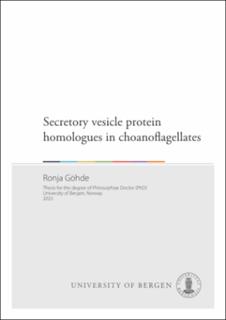| dc.contributor.author | Göhde, Ronja Alica Angelika | |
| dc.date.accessioned | 2023-12-04T13:12:17Z | |
| dc.date.available | 2023-12-04T13:12:17Z | |
| dc.date.issued | 2023-12-15 | |
| dc.date.submitted | 2023-11-14T09:30:52.225Z | |
| dc.identifier | container/74/cd/41/96/74cd4196-2f56-4050-a7e3-d493bb963828 | |
| dc.identifier.isbn | 9788230865927 | |
| dc.identifier.isbn | 9788230851753 | |
| dc.identifier.uri | https://hdl.handle.net/11250/3105837 | |
| dc.description.abstract | Regulert vesikeleksocytose, som i tilfellet med høyt spesialisert synaptisk vesikelsekresjon, styres av et sett evolusjonært konserverte proteiner. Mange av disse proteinene er eldre enn dyrene. Målet med denne avhandlingen var å studere opprinnelsen til og evolusjonen av pre-synaptiske proteinkomplekser som er viktige for transmitterfrigjøring. Hovedmodellorganismen jeg brukte til dette formålet, var choanoflagellaten Salpingoeca rosetta (S. rosetta). Choanoflagellater er ikke bare de nærmeste encellede slektningene til dyr, men de har også mange synaptiske proteinhomologer. Bruken av et bredt spekter av teknikker, som homologibaserte proteinsøk, 3D-vesikelrekonstruksjoner, immunfarging, genomredigering, subcellulær fraksjonering, immunopresipitering og massespektrometrisk analyse, muliggjorde direkte sammenligninger med synapser og synaptiske proteiner. Disse avslørte at choanoflagellater har mangfoldige, polariserte vesikellandskap og koder for mange av de undersøkte kjerneproteinene i nevrosekretoriske vesikler i genomene sine. Et av disse neurosekretoriske vesikelkjerneproteinene er en homolog til sekretorisk synaptobrevin, som ifølge immunfargingene er lokalisert ved begge vesikelrike poler i S. rosetta. I likhet med synapser er synaptobrevin i S. rosetta sannsynligvis lokalisert i membranen til vesikler som transporteres langs cytoskjelettet, noe immunfarging og subcellulær fraksjonering tyder på. Co-immunopresipitering (co-IP) med et antistoff mot synaptobrevin i S. rosetta avslørte flere potensielle interaksjonspartnere for synaptobrevin i S. rosetta, hvorav noen også ble funnet i proteomiske studier av synaptiske vesikler. Dessuten tyder CRISPR/Cas9-mediert knockout av synaptobrevin i S. rosetta på at synaptobrevin, i likhet med andre organismer, sannsynligvis er et essensielt protein for choanoflagellater. I likhet med synaptobrevin 2 fra dyr har synaptobrevin fra S. rosetta aminosyrer i nøkkelposisjoner som mistenkes å være viktige for substratgjenkjenning av botulinum nevrotoksin D (BoNT/D). I motsetning til dyrenes synaptobrevin 2 spaltes imidlertid ikke rekombinant synaptobrevin fra S. rosetta av BoNT/D. De observerte likhetene mellom vesikelsekresjonsmaskineriet hos choanoflagellater og dyresynapser tyder på at den regulerte vesikelsekresjonen har en felles opprinnelse som kan være eldre enn først antatt. | en_US |
| dc.description.abstract | Regulated vesicle exocytosis, as in the case of highly specialised synaptic vesicle secretion, is controlled by a set of evolutionarily conserved proteins. Many of these proteins predate animals. The aim of this thesis was to study the origin and evolution of presynaptic protein complexes that are important for transmitter release. The main model organism used for this purpose was the choanoflagellate species Salpingoeca rosetta (S. rosetta). Choanoflagellates are not only the closest unicellular relatives of animals, but they also possess numerous synaptic protein homologues. The use of a wide range of techniques, such as homology-based protein searches, 3D vesicle reconstructions, immunostaining, genome editing, subcellular fractionation, immunoprecipitation, and mass spectrometry analysis, allowed direct comparisons with synapses and synaptic proteins. These revealed that choanoflagellates possess diverse, polarised vesicular landscapes and encode many of the investigated core neurosecretory vesicle proteins in their genomes. One of these neurosecretory vesicle core proteins is a homologue of secretory synaptobrevin, which is localised at both vesicle-rich poles of S. rosetta according to immunostainings. Similar to synapses, synaptobrevin in S. rosetta is most likely located in the membrane of vesicles transported along the cytoskeleton, as suggested by immunostaining and subcellular fractionation results. Co-immunoprecipitation (co-IP) with an antibody against S. rosetta synaptobrevin uncovered several potential interaction partners of synaptobrevin in S. rosetta, some of which were also found in proteomic studies on synaptic vesicles. Moreover, CRISPR/Cas9-mediated knockouts of synaptobrevin in S. rosetta suggest that synaptobrevin, similar to other organisms, is likely an essential protein for choanoflagellates. Like animal synaptobrevin 2, S. rosetta synaptobrevin has amino acids at key positions suspected to be important for substrate recognition by botulinum neurotoxin D (BoNT/D). In contrast to animal synaptobrevin 2, however, recombinant S. rosetta synaptobrevin is not cleaved by BoNT/D. The observed similarities between the vesicle secretion machinery in choanoflagellates and animal synapses provide evidence for a common origin of regulated vesicle secretion, which may be older than originally thought. | en_US |
| dc.language.iso | eng | en_US |
| dc.publisher | The University of Bergen | en_US |
| dc.relation.haspart | Paper I: Göhde, R., Naumann, B., Laundon, D., Imig, C., McDonald, K., Cooper, B. H., Varoqueaux, F., Fasshauer, D. and Burkhardt, P. (2021). Choanoflagellates and the ancestry of neurosecretory vesicles. Philosophical Transactions of the Royal Society B, 376(1821), 20190759. The article is available at: <a href="https://hdl.handle.net/11250/2983037" target="blank">https://hdl.handle.net/11250/2983037</a> | en_US |
| dc.relation.haspart | Paper II: Göhde, R. and Burkhardt, P. Characteristics of secretory synaptobrevin homologues in the closest unicellular relative of animals. Not available in BORA. | en_US |
| dc.rights | In copyright | |
| dc.rights.uri | http://rightsstatements.org/page/InC/1.0/ | |
| dc.title | Secretory vesicle protein homologues in choanoflagellates | en_US |
| dc.type | Doctoral thesis | en_US |
| dc.date.updated | 2023-11-14T09:30:52.225Z | |
| dc.rights.holder | Copyright the Author. All rights reserved | en_US |
| dc.description.degree | Doktorgradsavhandling | |
| fs.unitcode | 12-60-0 | |
